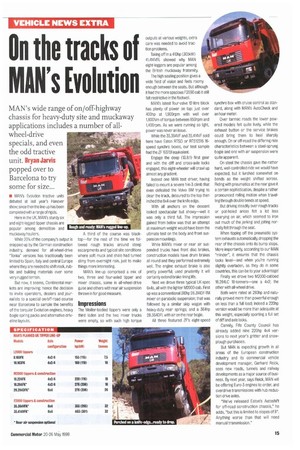On the tracks of MAN's Evolution
Page 17

If you've noticed an error in this article please click here to report it so we can fix it.
MAN's wide range of on/off-highway chassis for heavy-duty site and muckaway applications includes a number of allwheel-drive specials, and even the odd tractive unit. Bryan Jarvis popped over to Barcelona to try some for size...
• MAN's Evolution tractive units debuted at last year's Hanover show; since then the line-up has been completed with a range of rigids.
Here in the UK, MAN's sturdy six and eight-le ed tipper chassis are popular among demolition and muckaway hauliers.
While 20% of the company's output is snapped up by the German construction industry, demand for all-wheel-drive "Tonka" versions has traditionally been limited to Spain, Italy and central Europe where they are needed to shift rock, rubble and building materials over some very rugged terrain.
But now, it seems, Continental markets are improving: hence the decision to invite operators, dealers and journalists to a special on/off-road course near Barcelona to sample the benefits of the torquier Evolution engines, heavy bogie spring packs and alternative driveline layouts. A third of the course was blacktop—for the rest of the time we followed rough tracks around steep escarpments and typical site conditions where soft muck and shale had turned slimy from overnight rain, just to make things more interesting.
MAN's line-up comprised a mix of two, three and four-axled tipper and mixer chassis, some in all-wheel-drive guise and others with rear air suspension thrown in for good measure.
Impressions The iv1eiller-bodied tippers were only a third laden and the two mixer trucks were empty, so with such high torque
outputs at various weights, extra care was needed to avoid traction problems.
Taking off in a 410hp (305kW) 41.414VFL showed why MAN eight-loggers are popular among the British muckaway fraternity The high seating position gives a wide field of vision and feels roomy enough between the seats. But although it had the more spacious F2000 cab it still felt restrictive in the footwell.
MAN's latest four-valve 12-litre block has plenty of power on tap: just over 400hp at 1,900rpm with well over 1,800Nm of torque between 850rpm and 1,400rpm. As we were running so light, power was never an issue.
While the 35.364VF and 35.414VF sold here have Eaton RTSO or RTS12316 16speed synchro boxes, our test sample had the ZF 168151 equivalent.
Engage the deep (13.8:1) first gear and with the dff and cross-axle locks engaged, this eight-wheeler will crawl up almost any gradient.
Indeed one MAN test driver, having failed to mount a severe 1-in-3 climb that even defeated the Volvo BM trying to clear the track, detoured to the top then inched the 8x4 over the knife edge.
With all anchors on the descent looked spectacular but showy—well it was only a third full. The impression gained from below was that an attempt at maximum weight would have been the ultimate test on the body and front suspension mountings.
While MAN's mixer or rear air suspended trucks have front disc brakes, construction models have drum brakes all round and they performed extremely well. The engine exhaust brake is also pretty powerful; used prudently it will certainly extend brake-lining life.
Next we drove three typical UK-spec 6x45, all with the lighter M2000 cab. First up was a conventional 310hp 28.314DF-TM mixer on parabolic suspension; that was followed by a similar skip wagon with heavy-duty rear springs; and a 364hp 28.364DFL with air on the rear bogie.
All three featured ZF's eight-speed synchro box with cruise control as standard, along with MAN's AutoCheck and an hour meter, Over tarmac roads the lower powered models felt quite lively, while the exhaust button or the service brakes could bring them to heel sharply enough. On or off-road the differing ride characteristics between a steel-sprung bogie and one with air suspension were quite apparent.
On steel the chassis gave the rather hard, well-controlled ride we would have expected, but it lurched somewhat on bends as the weight shifted across. Riding with pneumatics at the rear gave it a certain sophistication, despite a rather pronounced rolling motion when travelling through double bends at speed.
But driving steadily over rough tracks or pot-holed areas felt a lot less wearying on air, which seemed to iron out much of the jerking and jolting normally felt through the seat.
When tipping off the pneumatic system exhausts automatically, dropping the rear of the chassis onto its bump stops. More importantly, according to our MAN "minder", it ensures that the chassis looks level—and when you're running slightly overladen, as they do in some countries, this can be to your advantage!
Finally we drove two M2000-cabbed 18.284LC 18-tonners—one a 4x2; the other with all-wheel drive.
Both were rated at 280hp and naturally proved more than powerful enough on less than a full load; indeed a 220hp version would be more than adequate at this weight, especially sporting a full set of cliff and axle locks.
Cannily, Fife County Council has already added nine 220hp 4x4 versions to next year's gritter and snowplough purchases.
But MAN is expecting growth in all areas of the European construction industry and its commercial vehicle development manager, Gerhard Reick, sees new roads, tunnels and railway developments as a major source of business. By next year, says Reick, MAN will be offering Euro-3 engines to order, and overdrive transmissions with hub reduction drive axles.
"We've released Eaton's Autoshift for off-road construction chassis," he adds, "but this is limited to slopes of 8°. Anything worse than that will need manual transmission."




















































































































